Battery Electric Storage Systems: Advances, Challenges, and Market Trends
Abstract
:1. Introduction
1.1. Motivation
1.2. Contributions
- Comprehensive Coverage: The document provides a thorough and comprehensive overview of BESSs and their diverse applications, addressing a wide range of scenarios, from power savings and grid stability to renewable energy integration and microgrid solutions. Furthermore, before proceeding with the comparison between lithium-ion batteries and solid-state batteries, it is essential to conduct a detailed analysis of lithium-ion batteries, emphasizing the various chemical technologies.
- Technical Insights: It offers valuable insights into the implementation of BESSs for every type of application, such as minimum cycles per year, power and energy ranges, C-rate considerations, and the best-suited battery chemistry for each application. For example, in the context of a grid stability application, the technical insights highlight the necessity for a high C-rate to rapidly release stored energy during grid disturbances. They also outline the preferred battery chemistries for this application, emphasizing the importance of lithium iron phosphate batteries for their enhanced safety and durability.
- Renewable Integration: The document underscores how BESS facilitates the seamless integration of RESs into the grid, optimizing energy supply–demand dynamics and supporting sustainability goals.
- Market Trends: The document analyses current and projected market trends for both FTM and BTM applications, offering valuable data and insights for stakeholders in the energy sector. For example, in the field of FTM applications, the document discusses the ongoing trend of increasing investment in large-scale BESS projects, such as those associated with utility-scale renewable energy integration. It highlights that this trend is driven by a combination of government incentives, renewable energy targets, and the need for grid stabilization, paving the way for substantial growth in the energy storage sector.
1.3. Paper Organization
2. Literature Review
3. BESS Architecture
- At the heart of a BESS are the battery modules, which are interconnected to form a larger battery pack. These modules are typically composed of multiple individual battery cells, arranged in series and parallel configurations to meet the system’s voltage and capacity requirements.
- The battery management system (BMS) is responsible for monitoring and controlling the performance of the battery modules. It ensures the proper charging and discharging of the batteries, monitors their state of charge (SoC), state of health (SoH), temperature, and voltage levels, and protects the batteries from overcharging, over-discharging, and thermal issues. The BMS also manages the balancing of cells within each module to ensure uniform performance and longevity of the battery pack [32,33,34]. It ensures the safe and efficient operation of the battery pack. Alongside technological advancements, the BMS sector faces significant challenges. Cost management remains a priority as energy storage systems become increasingly widespread and competitive in the market. BMS costs must remain affordable to enable the widespread adoption of these systems. Furthermore, interoperability and standardization are fundamental issues, as the diversity of BMS technologies can hinder the interconnection and compatibility of various energy storage systems. Current research focuses on solutions to improve interoperability and create shared standards for BMS. Other emerging challenges include the management of critical resources and materials required for battery production. In this context, research into new BMS technologies aims to maximize resource efficiency and reduce environmental impact. These challenges and opportunities underscore the importance of ongoing discussion on recent developments and challenges in the BMS sector, as this is crucial for the future of energy storage systems.
- The power conversion system (PCS) is a fundamental component within a BESS and plays a crucial role in ensuring the effective operation of the system as a whole. The PCS consists of several key elements, including inverters, transformers, and control circuits. Inverters are responsible for converting the direct current (DC) electrical energy stored in batteries into alternating current (AC) that can be used by electrical devices or injected into the electrical grid. This step is crucial, as it enables the BESS to be interoperable with other energy sources and support grid balancing. Transformers play an important role in adjusting the voltage of the converted energy to the specific requirements of the load or the grid. Additionally, the control circuits of the PCS efficiently manage the charging and discharging operations of the batteries, ensuring that the batteries are kept within safe voltage and temperature limits. The interaction of the PCS with the BMS is critical since the BMS provides information to the PCS about the state of the batteries and optimal operating conditions. This bidirectional communication between the PCS and the BMS is essential for maintaining battery performance and lifespan. Moreover, in a grid-connected BESS, the PCS can perform grid support functions, such as frequency regulation and voltage control, to ensure the stability of the electrical system. The authors in this paper [35] analyse the relationship between the BESS design scheme and the PCS.
- The energy management system (EMS) is a central control unit that monitors and optimizes the overall operation of the BESS. It collects real-time data from the BMS and power conversion system, analyses the energy storage requirements, and determines the most effective strategies for charging and discharging the batteries. The EMS can be programmed to prioritize different objectives, such as maximizing self-consumption of renewable energy, participating in grid services, or optimizing economic returns [36,37].
- To enable seamless integration with the electrical grid and RESs, a BESS typically incorporates communication interfaces and protocols [38]. These allow for real-time monitoring, control, and communication with other grid-connected devices, such as renewable energy systems or smart grid infrastructure. Communication capabilities enable remote monitoring of system performance, diagnostics, and software updates.
- Safety Systems: A BESS is housed in an enclosure designed to protect the components from environmental factors and ensure safety. The enclosure provides physical support, thermal management, and protection against fire, shock, and other hazards. Safety systems, such as fire suppression systems, smoke detectors, and emergency shutdown mechanisms, are also incorporated to mitigate potential risks [39].
3.1. Lithium-Ion Battery Chemistry
| Lithium Cobalt Oxide—LCO batteries have high specific energy but shorter life, lower thermal stability, and defined load abilities. Modern designs include nickel, manganese, and/or aluminium to improve longevity and cost [44]. | 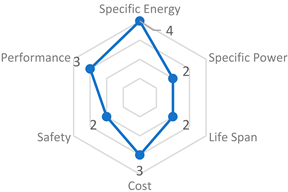 |
| Lithium Manganese Oxide—LMO batteries offer higher thermal stability and safety but have a lower capacity compared to LCO batteries. They are often combined with nickel manganese cobalt oxide (NMC) for increased specific energy and extended life [45]. |  |
| Lithium Nickel Manganese Cobalt Oxide—NMC batteries combine nickel, manganese, and cobalt to achieve a balance between specific energy and stability. They are commonly used in power tools, EVs, and electric propulsion systems [46]. |  |
| Lithium Iron Phosphate—LFP batteries offer good electrochemical performance, low resistance, and increased safety. They have a lower specific energy but have a longer cycle life and thermal stability [47]. | 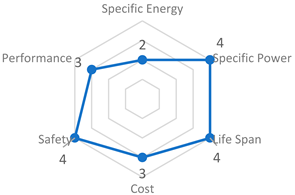 |
| Lithium Nickel Cobalt Aluminium Oxide—NCA batteries provide high specific energy, relatively good specific power, and longer life. They are used in specific applications but have higher costs and lower safety compared to other chemistries [48]. | 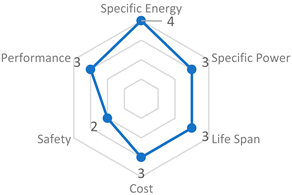 |
| Lithium Titanate—LTO batteries replace graphite at the anode and offer advantages such as safety, excellent discharge properties at low temperatures, and high thermal stability. However, they have a lower specific energy and higher costs compared to other lithium-ion systems [49]. |  |
3.2. Characteristics of Solid-State Batteries
3.3. Comparison of BESS with Other Energy Storage Technologies
4. Available Technologies for BESS
- FTM batteries are integrated into distribution or transmission networks or in connection with a production property. They allow applications needed by system operators, such as auxiliary services or system load reductions.
- BTM batteries are connected behind the electricity meter of commercial, industrial, or residential customers, mainly with the aim of reducing electricity bills through demand-side management.
4.1. FTM BESS Concept
4.2. BTM BESS Concept
5. BESS Services
5.1. Bulk Energy Services
- Electric Supply Capacity (a)
- Electric Energy Time-Shift (Arbitrage) (b)
5.2. Ancillary Services
- Frequency Regulation (a)
- Voltage Support (b)
- Black Start (c)
- Spinning, Non-Spinning Reserves (d)
- ✓
- Spinning Storage: it refers to capacity that is directly connected and synchronized with the network, capable of swiftly responding to compensate for production or transmission interruptions. Spinning reserves represent the primary backup source utilized in the event of a power outage.
- ✓
- Non-Rotating Storage: it is connected to the network but operates asynchronously. It can typically be brought online within 10 min, serving as a valuable resource for uninterrupted loads. Examples include offline or block generation capacity.
- ✓
- Supplementary Storage: it becomes available within an hour and typically serves as a backup for both rotating and non-rotating storage resources. Supplementary reserves come into play after all rotating reserves are operational.
5.3. Grid Support (T&D)
- Transmission and Distribution Congestion Relief (a)
- Transmission and Distribution Upgrade Deferrals (b)
5.4. Renewable Energy Integration
- Renewable Firm Capacity or Peaking Capacity
- ✓
- Optimization of Generation Profiles: capacity firming optimizes the generation patterns of renewable sources, ensuring consistent and reliable power output.
- ✓
- Reactive Power Support: capacity firming facilitates the supply and exchange of reactive power to support RESs, enhancing their performance and grid stability.
- ✓
- Balancing Load Currents: it assists in balancing load currents and compensating for imbalances that might not always be accommodated by RESs.
5.5. Customer Energy Management Services
- ✓
- Lithium-Cobalt Dioxide Accumulators: These are favoured for applications such as cell phones and EVs, where a compact, lightweight battery with high energy and power density is essential.
- ✓
- Lithium Iron Phosphate Accumulators: These are well-suited for building applications, where weight and size are less critical, and longevity takes precedence.
- ✓
- NCM Batteries: By incorporating nickel and manganese, originally designed for cell phones, NCM batteries have been adapted for use in buildings, offering a balance between energy density and cost-effectiveness.
- Peak Shaving (a)
- Power Upgrade Deferral (b)
- Time-of-use Energy Cost Management (c)
- Maximizing/Optimizing Self-production (d)
- Renewable Integration (e)
- ✓
- Partial Load Operation: BESSs can effectively operate at partial load with minimal performance degradation, enhancing overall system efficiency.
- ✓
- Rapid Response: BESSs can swiftly respond to varying electrical loads, adapting to changing conditions in real-time.
- ✓
- Load Following Capability: BESSs are well-suited for both load following down (matching load reductions) and load following up (meeting increased demand) by either charging or discharging energy as needed.
- ✓
- Grid Variability Smoothing: BESS technology plays a crucial role in mitigating grid variability associated with fluctuations in renewable energy generation.
- Back-up Power (f)
- Power Quality (g)
- ✓
- Voltage Magnitude Fluctuations: This includes short-term voltage jumps or drops, as well as long-term fluctuations or reductions in voltage levels.
- ✓
- Frequency Variations: Changes in the initial frequency at which the power is delivered.
- ✓
- Low Power Factor: Indicating an excessive phase difference between voltage and current, resulting in inefficient power transfer.
- ✓
- Harmonics: The presence of current or voltage components at frequencies other than the primary frequency, causing distortion.
- ✓
- Service Interruptions: These can occur at any time, ranging from fractions of a second to a few seconds.
- Compensation of the Reactive Power (h)
- Energy Independence (i)
- ✓
- Energy Source Integration: Microgrids typically incorporate solar PVs as a primary energy source, but they can integrate other renewable energy assets like wind turbines. This diversity contributes to their resilience and sustainability.
- ✓
- Grid Interactivity: Microgrids can be designed to interact with the national electricity market (NEM) or operate as fully independent systems, providing flexibility in how they connect with broader energy networks.
- ✓
- Customization: Microgrid solutions are highly customizable to suit specific needs, ensuring the highest levels of quality, safety, and performance in line with the unique requirements of each deployment.
- EV Fast Charging (j)
- ✓
- BESS Integration with Residential RES: This approach involves deploying BES systems in households in conjunction with RESs, particularly PV, to support EV charging. The goal is to reduce the impact of EVs on household voltage and power quality while minimizing charging costs [80].
- ✓
6. Market Trends
7. Conclusions
Author Contributions
Funding
Conflicts of Interest
Abbreviations
| AC | Alternating Current |
| BESS | Battery Energy Storage System |
| BM | Balancing Market |
| BMS | Battery Management System |
| BNEF | Bloomberg New Energy Finance |
| BTM | Behind the Meter |
| CS | Charging Station |
| DC | Direct Current |
| DG | Distributed Generation |
| DNO | Distribution Network Operator |
| DSO | Distribution System Operator |
| ESS | Energy Storage System |
| EMS | Energy Management System |
| EU | European Union |
| EV | Electric Vehicle |
| FCR | Frequency Containment Reserve |
| FTM | Front of the Meter |
| GHG | Greenhouse Gas |
| LCO | Lithium Cobalt Oxide |
| LFP | Lithium Iron Phosphate |
| LMO | Lithium Manganese Oxide |
| LTO | Lithium Titanate |
| NCA | Lithium Nickel Cobalt Aluminium Oxide |
| NEM | National Electricity Market |
| NMC | Lithium Nickel Manganese Cobalt |
| PCS | Power Conversion System |
| PV | Photovoltaic |
| RES | Renewable Energy Sources |
| SoC | State of Charge |
| SoH | State of Health |
| T&D | Transmission and Distribution |
| TOU | Time-Of-Use |
| TSO | Transmission System Operator |
| VRE | Variable Renewable Energy |
References
- Vatalis, K.I.; Avlogiaris, G.; Tsalis, T.A. Just transition pathways of energy decarbonization under the global environmental changes. J. Environ. Manag. 2022, 309, 114713. [Google Scholar] [CrossRef] [PubMed]
- Horowitz, C.A. Paris Agreement. Int. Leg. Mater. 2016, 55, 740–755. [Google Scholar] [CrossRef]
- Hannan, M.A.; Al-Shetwi, A.Q.; Begum, R.A.; Ker, P.J.; Rahman, S.A.; Mansor, M.; Mia, M.S.; Muttaqi, K.M.; Dong, Z.Y. Impact assessment of battery energy storage systems towards achieving sustainable development goals. J. Energy Storage 2021, 42, 103040. [Google Scholar] [CrossRef]
- Psarros, G.N.; Papathanassiou, S.A. Electricity storage requirements to support the transition towards high renewable penetration levels—Application to the Greek power system. J. Energy Storage 2022, 55, 105748. [Google Scholar] [CrossRef]
- Letcher, T.M. Global warming, greenhouse gases, renewable energy, and storing energy. In Storing Energy; Elsevier: Amsterdam, The Netherlands, 2022; pp. 3–12. [Google Scholar] [CrossRef]
- Lipu, M.S.H.; Mamun, A.A.; Ansari, S.; Miah, M.S.; Hasan, K.; Meraj, S.T.; Abdolrasol, M.G.; Rahman, T.; Maruf, M.H.; Sarker, M.R.; et al. Battery Management, Key Technologies, Methods, Issues, and Future Trends of Electric Vehicles: A Pathway toward Achieving Sustainable Development Goals. Batteries 2022, 8, 119. [Google Scholar] [CrossRef]
- Jafari, M.; Botterud, A.; Sakti, A. Decarbonizing power systems: A critical review of the role of energy storage. Renew. Sustain. Energy Rev. 2022, 158, 112077. [Google Scholar] [CrossRef]
- Hoeft, F. Internal combustion engine to electric vehicle retrofitting: Potential customer’s needs, public perception and business model implications. Transp. Res. Interdiscip. Perspect. 2021, 9, 100330. [Google Scholar] [CrossRef]
- Ballinger, B.; Stringer, M.; Schmeda-Lopez, D.R.; Kefford, B.; Parkinson, B.; Greig, C.; Smart, S. The vulnerability of electric vehicle deployment to critical mineral supply. Appl. Energy 2019, 255, 113844. [Google Scholar] [CrossRef]
- Speirs, J.; Contestabile, M.; Houari, Y.; Gross, R. The future of lithium availability for electric vehicle batteries. Renew. Sustain. Energy Rev. 2014, 35, 183–193. [Google Scholar] [CrossRef]
- Šimić, Z.; Topić, D.; Knežević, G.; Pelin, D. Battery energy storage technologies overview. Int. J. Electr. Comput. Eng. Syst. 2021, 12, 53–65. [Google Scholar] [CrossRef]
- Hidalgo-León, R.; Siguenza, D.; Sanchez, C.; León, J.; Jácome-Ruiz, P.; Wu, J.; Ortiz, D. A survey of battery energy storage system (BESS), applications and environmental impacts in power systems. In Proceedings of the 2017 IEEE Second Ecuador Technical Chapters Meeting (ETCM), Salinas, Ecuador, 16–20 October 2017; pp. 1–6. [Google Scholar] [CrossRef]
- Hannan, M.A.; Wali, S.B.; Ker, P.J.; Abd Rahman, M.S.; Mansor, M.; Ramachandaramurthy, V.K.; Muttaqi, K.M.; Mahlia, T.M.I.; Dong, Z.Y. Battery energy-storage system: A review of technologies, optimization objectives, constraints, approaches, and outstanding issues. J. Energy Storage 2021, 42, 103023. [Google Scholar] [CrossRef]
- Duerr, S.; Ababei, C.; Ionel, D.M. Load Balancing with Energy Storage Systems Based on co-Simulation of Multiple Smart Buildings and Distribution Networks. In Proceedings of the 2017 IEEE 6th International Conference on Renewable Energy Research and Applications (ICRERA), San Diego, CA, USA, 5–8 November 2017; pp. 175–180. [Google Scholar] [CrossRef]
- Gusev, Y.P.; Subbotin, P.V. Using Battery Energy Storage Systems for Load Balancing and Reactive Power Compensation in Distribution Grids. In Proceedings of the 2019 International Conference on Industrial Engineering, Applications and Manufacturing (ICIEAM), Sochi, Russia, 25–29 March 2019; pp. 1–5. [Google Scholar] [CrossRef]
- Lawder, M.T.; Suthar, B.; Northrop, P.W.; De, S.; Hoff, C.M.; Leitermann, O.; Crow, M.L.; Santhanagopalan, S.; Subramanian, V.R. Battery Energy Storage System (BESS) and Battery Management System (BMS) for Grid-Scale Applications. Proc. IEEE 2014, 102, 1014–1030. [Google Scholar] [CrossRef]
- Zich, J.; Jandik, J. Active Battery Management System for Home Battery Energy Storage. In Proceedings of the 2020 21st International Scientific Conference on Electric Power Engineering (EPE), Prague, Czech Republic, 19–21 October 2020; pp. 1–4. [Google Scholar] [CrossRef]
- Byrne, R.H.; Nguyen, T.A.; Copp, D.A.; Chalamala, B.R.; Gyuk, I. Energy Management and Optimization Methods for Grid Energy Storage Systems. IEEE Access 2018, 6, 13231–13260. [Google Scholar] [CrossRef]
- Keshan, H.; Thornburg, J.; Ustun, T.S. Comparison of Lead-Acid and Lithium Ion Batteries for Stationary Storage in Off-Grid Energy Systems. In Proceedings of the 4th IET Clean Energy and Technology Conference (CEAT 2016), Institution of Engineering and Technology, Kuala Lumpur, Malaysia, 14–15 November 2016; p. 30. [Google Scholar] [CrossRef]
- Saini, V.K.; Seervi, A.; Kumar, R.; Sujil, A.; Mahmud, M.A.; Al-Sumaiti, A.S. Cloud Energy Storage Based Embedded Battery Technology Architecture for Residential Users Cost Minimization. IEEE Access 2022, 10, 43685–43702. [Google Scholar] [CrossRef]
- del Valle, J.A.; Ansean, D.; Viera, J.C.; Antuna, J.L.; Gonzalez, M.; Garcia, V. Analysis of Advanced Lithium-Ion Batteries for Battery Energy Storage Systems. In Proceedings of the 2018 IEEE International Conference on Environment and Electrical Engineering and 2018 IEEE Industrial and Commercial Power Systems Europe (EEEIC/I&CPS Europe), Palermo, Italy, 12–15 June 2018; pp. 1–6. [Google Scholar] [CrossRef]
- Galvan, E.; Mandal, P.; Sang, Y. Networked microgrids with roof-top solar PV and battery energy storage to improve distribution grids resilience to natural disasters. Int. J. Electr. Power Energy Syst. 2020, 123, 106239. [Google Scholar] [CrossRef]
- Aghamohamadi, M.; Abdar, A. Charging Management of Chemical Lithium Nickel Cobalt Aluminum Oxide (LiNiCoAlO2) Batteries, Considering Battery Degradation Effects under Uncertain Operation in Multi-Energy Systems. In Proceedings of the 2020 IEEE International Conference on Power Electronics, Drives and Energy Systems (PEDES), Jaipur, India, 16–19 December 2020; pp. 1–6. [Google Scholar] [CrossRef]
- Hamidi, A.; Weber, L.; Nasiri, A. EV Charging Station Integrating Renewable Energy and Second-Life Battery. In Proceedings of the 2013 International Conference on Renewable Energy Research and Applications (ICRERA), Madrid, Spain, 20–23 October 2013; pp. 1217–1221. [Google Scholar] [CrossRef]
- Li, Y.; Feng, B.; Li, G.; Qi, J.; Zhao, D.; Mu, Y. Optimal distributed generation planning in active distribution networks considering integration of energy storage. Appl. Energy 2018, 210, 1073–1081. [Google Scholar] [CrossRef]
- Medghalchi, Z.; Taylan, O. A novel hybrid optimization framework for sizing renewable energy systems integrated with energy storage systems with solar photovoltaics, wind, battery and electrolyzer-fuel cell. Energy Convers. Manag. 2023, 294, 117594. [Google Scholar] [CrossRef]
- Zyryanov, V.; Kiryanova, N.; Korotkov, I.; Nesterenko, G.; Prankevich, G.; Rudiuk, I. Analysis of Energy Storage Systems Application in the Russian and World Electric Power Industry. In Proceedings of the 2020 Ural Smart Energy Conference (USEC), Ekaterinburg, Russia, 13–15 November 2020; pp. 106–109. [Google Scholar] [CrossRef]
- Stecca, M.; Elizondo, L.R.; Soeiro, T.B.; Bauer, P.; Palensky, P. A Comprehensive Review of the Integration of Battery Energy Storage Systems into Distribution Networks. IEEE Open J. Ind. Electron. Soc. 2020, 1, 46–65. [Google Scholar] [CrossRef]
- Benini, M.; Canevese, S.; Cirio, D.; Gatti, A. Participation of Battery Energy Storage Systems in the Italian Balancing Market: Management Strategies and Economic Results. In Proceedings of the 2018 IEEE International Conference on Environment and Electrical Engineering and 2018 IEEE Industrial and Commercial Power Systems Europe (EEEIC/I&CPS Europe), Palermo, Italy, 12–15 June 2018; pp. 1–6. [Google Scholar] [CrossRef]
- Figgener, J.; Stenzel, P.; Kairies, K.P.; Linßen, J.; Haberschusz, D.; Wessels, O.; Angenendt, G.; Robinius, M.; Stolten, D.; Sauer, D.U. The development of stationary battery storage systems in Germany—A market review. J. Energy Storage 2020, 29, 101153. [Google Scholar] [CrossRef]
- Telaretti, E.; Dusonchet, L. Stationary Battery Systems in the Main World Markets: Part 1: Overview of the State-of-The-Art. In Proceedings of the 2017 IEEE International Conference on Environment and Electrical Engineering and 2017 IEEE Industrial and Commercial Power Systems Europe (EEEIC/I&CPS Europe), Milan, Italy, 6–9 June 2017; pp. 1–5. [Google Scholar] [CrossRef]
- Spoorthi, B.; Pradeepa, P. Review on Battery Management System in EV. In Proceedings of the 2022 International Conference on Intelligent Controller and Computing for Smart Power (ICICCSP), Hyderabad, India, 21–23 July 2022; pp. 1–4. [Google Scholar] [CrossRef]
- Rajendran, G.; Vaithilingam, C.A.; Misron, N.; Naidu, K.; Ahmed, M.R. A comprehensive review on system architecture and international standards for electric vehicle charging stations. J. Energy Storage 2021, 42, 103099. [Google Scholar] [CrossRef]
- See, K.W.; Wang, G.; Zhang, Y.; Wang, Y.; Meng, L.; Gu, X.; Zhang, N.; Lim, K.C.; Zhao, L.; Xie, B. Critical review and functional safety of a battery management system for large-scale lithium-ion battery pack technologies. Int. J. Coal Sci. Technol. 2022, 9, 36. [Google Scholar] [CrossRef]
- Liu, M.; Cao, X.; Cao, C.; Wang, P.; Wang, C.; Pei, J.; Lei, H.; Jiang, X.; Li, R.; Li, J. A Review of Power Conversion Systems and Design Schemes of High-Capacity Battery Energy Storage Systems. IEEE Access 2022, 10, 52030–52042. [Google Scholar] [CrossRef]
- Lee, D.; Cheng, C.-C. Energy savings by energy management systems: A review. Renew. Sustain. Energy Rev. 2016, 56, 760–777. [Google Scholar] [CrossRef]
- Reihani, E.; Sepasi, S.; Roose, L.R.; Matsuura, M. Energy management at the distribution grid using a Battery Energy Storage System (BESS). Int. J. Electr. Power Energy Syst. 2016, 77, 337–344. [Google Scholar] [CrossRef]
- Hänsch, K.; Naumann, A.; Wenge, C.; Wolf, M. Communication for battery energy storage systems compliant with IEC 61850. Int. J. Electr. Power Energy Syst. 2018, 103, 577–586. [Google Scholar] [CrossRef]
- Conzen, J.; Lakshmipathy, S.; Kapahi, A.; Kraft, S.; DiDomizio, M. Lithium ion battery energy storage systems (BESS) hazards. J. Loss Prev. Process. Ind. 2023, 81, 104932. [Google Scholar] [CrossRef]
- Wong, D.N.; Wetz, D.A.; Mansour, A.M.; Heinzel, J.M. The Influence of High C Rate Pulsed Discharge on Lithium-Ion Battery Cell Degradation. In Proceedings of the 2015 IEEE Pulsed Power Conference (PPC), Austin, TX, USA, 31 May–4 June 2015; pp. 1–6. [Google Scholar] [CrossRef]
- BU-410: Charging at High and Low Temperatures. Available online: https://batteryuniversity.com/article/bu-410-charging-at-high-and-low-temperatures#:~:text=Lithium%20Ion%3A%20Li%2Dion%20can,diffusion%20rates%20on%20the%20anode (accessed on 12 September 2023).
- Stan, A.-I.; Swierczynski, M.; Stroe, D.-I.; Teodorescu, R.; Andreasen, S.J. Lithium Ion Battery Chemistries from Renewable Energy Storage to Automotive and Back-Up Power Applications—An Overview. In Proceedings of the 2014 International Conference on Optimization of Electrical and Electronic Equipment (OPTIM), Bran, Romania, 22–24 May 2014; pp. 713–720. [Google Scholar] [CrossRef]
- Willem, R. Lithium Battery Prices Plunge. Available online: https://www.statista.com/chart/23807/lithium-ion-battery-prices/ (accessed on 12 September 2023).
- Kannan, D.R.R.; Weatherspoon, M.H. The effect of pulse charging on commercial lithium nickel cobalt oxide (NMC) cathode lithium-ion batteries. J. Power Sources 2020, 479, 229085. [Google Scholar] [CrossRef]
- Thackeray, M.M.; Johnson, C.S.; Vaughey, J.T.; Li, H.N.; Hackney, S.A. Advances in manganese-oxide ‘composite’ electrodes for lithium-ion batteries. J. Mater. Chem. 2005, 15, 2257. [Google Scholar] [CrossRef]
- Baccouche, I.; Jemmali, S.; Manai, B.; Nikolian, A.; Omar, N.; Essoukri Ben Amara, N. Li-ion battery modeling and characterization: An experimental overview on NMC battery. Int. J. Energy Res. 2022, 46, 3843–3859. [Google Scholar] [CrossRef]
- Wang, M.; Liu, K.; Dutta, S.; Alessi, D.S.; Rinklebe, J.; Ok, Y.S.; Tsang, D.C. Recycling of lithium iron phosphate batteries: Status, technologies, challenges, and prospects. Renew. Sustain. Energy Rev. 2022, 163, 112515. [Google Scholar] [CrossRef]
- Ekawati, K.D.R.; Sholikah, A.P.; Yudha, C.S.; Widiyandari, H.; Purwanto, A. Comparative Study of NCA Cathode Material Synthesis Methods towards Their Structure Characteristics. In Proceedings of the 2018 5th International Conference on Electric Vehicular Technology (ICEVT), Surakarta, Indonesia, 30–31 October 2018; pp. 57–61. [Google Scholar] [CrossRef]
- Parthasarathy, C.; Laaksonen, H.; Halagi, P. Characterisation and Modelling Lithium Titanate Oxide Battery Cell by Equivalent Circuit Modelling Technique. In Proceedings of the 2021 IEEE PES Innovative Smart Grid Technologies—Asia (ISGT Asia), Brisbane, Australia, 5–8 December 2021; pp. 1–5. [Google Scholar] [CrossRef]
- Global Cell Prices Fall Below $100/kWh for First Time in Two Years. Available online: https://source.benchmarkminerals.com/article/global-cell-prices-fall-below-100-kwh-for-first-time-in-two-years (accessed on 31 October 2023).
- Bruno, V. Visualized: How Much Do EV Batteries Cost? Available online: https://www.visualcapitalist.com/visualized-how-much-do-ev-batteries-cost/#:~:text=Lithium%20nickel%20cobalt%20aluminum%20oxide,point%20at%20%24112.7%20per%20kWh (accessed on 31 October 2023).
- Schnell, J.; Günther, T.; Knoche, T.; Vieider, C.; Köhler, L.; Just, A.; Keller, M.; Passerini, S.; Reinhart, G. All-solid-state lithium-ion and lithium metal batteries—Paving the way to large-scale production. J. Power Sources 2018, 382, 160–175. [Google Scholar] [CrossRef]
- Anuj. Solid State Battery vs Lithium Ion: Which One Is Better 2023? 2023. Available online: https://evbatteryhub.com/solid-state-battery-vs-lithium-ion-energy-density/ (accessed on 14 September 2023).
- Bates, M.; Preger, Y.; Torres-Castro, L.; Harrison, K.L.; Harris, S.J.; Hewson, J. Are solid-state batteries safer than lithium-ion batteries? Joule 2022, 6, 742–755. [Google Scholar] [CrossRef]
- Alex, E. Understanding the Energy Storage World Leaders, Anticipating the Next Big Markets. 2017. Available online: https://www.energy-storage.news/understanding-the-energy-storage-world-leaders-anticipating-the-next-big-markets/ (accessed on 12 September 2023).
- Chen, H.; Cong, T.N.; Yang, W.; Tan, C.; Li, Y.; Ding, Y. Progress in electrical energy storage system: A critical review. Prog. Nat. Sci. 2009, 19, 291–312. [Google Scholar] [CrossRef]
- Baker, J.N.; Collinson, A. Electrical energy storage at the turn of the Millennium. Power Eng. J. 1999, 13, 107–112. [Google Scholar] [CrossRef]
- Sa’ed, J.; Favuzza, S.; Massaro, F.; Telaretti, E. Optimization of BESS Capacity Under a Peak Load Shaving Strategy. In Proceedings of the 2018 IEEE International Conference on Environment and Electrical Engineering and 2018 IEEE Industrial and Commercial Power Systems Europe (EEEIC/I&CPS Europe), Palermo, Italy, 12–15 June 2018; pp. 1–4. [Google Scholar] [CrossRef]
- Malhotra, A.; Battke, B.; Beuse, M.; Stephan, A.; Schmidt, T. Use cases for stationary battery technologies: A review of the literature and existing projects. Renew. Sustain. Energy Rev. 2016, 56, 705–721. [Google Scholar] [CrossRef]
- Kim, Y.-J. Experimental Study of Battery Energy Storage Systems Participating in Grid Frequency Regulation. In Proceedings of the 2016 IEEE/PES Transmission and Distribution Conference and Exposition (T&D), Dallas, TX, USA, 3–5 May 2016; pp. 1–5. [Google Scholar] [CrossRef]
- Jo, H.; Choi, J.; Agyeman, K.A.; Han, S. Development of Frequency Control Performance Evaluation Criteria of BESS for Ancillary Service: A Case Study of Frequency Regulation by KEPCO. In Proceedings of the 2017 IEEE Innovative Smart Grid Technologies—Asia (ISGT-Asia), Auckland, New Zealand, 4–7 December 2017; pp. 1–5. [Google Scholar] [CrossRef]
- Krata, J.; Saha, T.K. Real-Time Coordinated Voltage Support With Battery Energy Storage in a Distribution Grid Equipped with Medium-Scale PV Generation. IEEE Trans. Smart Grid. 2019, 10, 3486–3497. [Google Scholar] [CrossRef]
- Tongge, L.; Yonghong, H.; Junyi, M.; Yimin, X. The Research on Black Start Strategy of Distributed Photovoltaic-Battery Energy Storage Systems Based on Cluster Division. In Proceedings of the 2020 IEEE Sustainable Power and Energy Conference (iSPEC), Chengdu, China, 23–25 November 2020; pp. 337–342. [Google Scholar] [CrossRef]
- Li, J.; You, H.; Qi, J.; Kong, M.; Zhang, S.; Zhang, H. Stratified Optimization Strategy Used for Restoration with Photovoltaic-Battery Energy Storage Systems as Black-Start Resources. IEEE Access 2019, 7, 127339–127352. [Google Scholar] [CrossRef]
- Usama, M.U.; Kelle, D.; Baldwin, T. Utilizing Spinning Reserves as Energy Storage for Renewable Energy Integration. In Proceedings of the 2014 Clemson University Power Systems Conference, Clemson, SC, USA, 11–14 March 2014; pp. 1–5. [Google Scholar] [CrossRef]
- Gowda, S.N.; Zhang, T.; Kim, C.J.; Gadh, R.; Nazaripouya, H. Transmission, Distribution deferral and Congestion relief services by Electric Vehicles. In Proceedings of the 2019 IEEE Power & Energy Society Innovative Smart Grid Technologies Conference (ISGT), Washington, DC, USA, 18–21 February 2019; pp. 1–5. [Google Scholar] [CrossRef]
- Eyer, J. Electric Utility Transmission and Distribution Upgrade Deferral Benefits from Modular Electricity Storage: A Study for the DOE Energy Storage Systems Program; Sandia National Laboratories (SNL): Albuquerque, NM, USA; Livermore, CA, USA, 2009. [Google Scholar] [CrossRef]
- Eyer, J.; Corey, G. Energy Storage for the Electricity Grid: Benefits and Market Potential Assessment Guide: A Study for the DOE Energy Storage Systems Program; Sandia National Laboratories (SNL): Albuquerque, NM, USA; Livermore, CA, USA, 2010. [Google Scholar] [CrossRef]
- Suberu, M.Y.; Mustafa, M.W.; Bashir, N. Energy storage systems for renewable energy power sector integration and mitigation of intermittency. Renew. Sustain. Energy Rev. 2014, 35, 499–514. [Google Scholar] [CrossRef]
- Li, X.; Hui, D.; Lai, X. Battery Energy Storage Station (BESS)-Based Smoothing Control of Photovoltaic (PV) and Wind Power Generation Fluctuations. IEEE Trans. Sustain. Energy 2013, 4, 464–473. [Google Scholar] [CrossRef]
- Oudalov, A.; Cherkaoui, R.; Beguin, A. Sizing and Optimal Operation of Battery Energy Storage System for Peak Shaving Application. In Proceedings of the 2007 IEEE Lausanne Power Tech, Lausanne, Switzerland, 1–5 July 2007; pp. 621–625. [Google Scholar] [CrossRef]
- Willis, H.L. Power Distribution Planning Reference Book; CRC Press: Boca Raton, FL, USA, 2004. [Google Scholar] [CrossRef]
- Gil, H.A.; Joos, G. On the Quantification of the Network Capacity Deferral Value of Distributed Generation. IEEE Trans. Power Syst. 2006, 21, 1592–1599. [Google Scholar] [CrossRef]
- Mbungu, N.T.; Bansal, R.C.; Naidoo, R.M.; Siti, M.W. Analysis of a Grid-Connected Battery Energy Storage Based Energy Management System. In Proceedings of the 2020 First International Conference on Power, Control and Computing Technologies (ICPC2T), Raipur, India, 3–5 January 2020; pp. 1–5. [Google Scholar] [CrossRef]
- Peng, C.-Y.; Kuo, C.-C.; Tsai, C.-T. Optimal Configuration with Capacity Analysis of PV-Plus-BESS for Behind-the-Meter Application. Appl. Sci. 2021, 11, 7851. [Google Scholar] [CrossRef]
- Qatan, M.S.; Hepburn, D.M.; Zhou, C. Development of a Back-Up Battery Management System—A Case Study in Petroleum Development Oman. In Proceedings of the IEEE EUROCON 2009, St. Petersburg, Russia, 18–23 May 2009; pp. 475–479. [Google Scholar] [CrossRef]
- Yukita, K.; Ichiyanagi, K.; Goto, Y.; Hirose, K. A Study of Electric Power Quality Using Storage System in Distributed Generation. In Proceedings of the 2007 9th International Conference on Electrical Power Quality and Utilisation, Barcelona, Spain, 9–11 October 2007; pp. 1–4. [Google Scholar] [CrossRef]
- Rouco, L.; Sigrist, L. Active and Reactive Power Control of Battery Energy Storage Systems in Weak Grids. In Proceedings of the 2013 IREP Symposium Bulk Power System Dynamics and Control—IX Optimization, Security and Control of the Emerging Power Grid, Rethymno, Greece, 25–30 August 2013; pp. 1–7. [Google Scholar] [CrossRef]
- Jo, J.; Cha, H. A Comparative Analysis of Stability for Battery Energy Storage System Operating with Diesel Generator in a Stand-Alone Microgrid. In Proceedings of the 2018 IEEE International Conference on Industrial Electronics for Sustainable Energy Systems (IESES), Hamilton, New Zealand, 31 January–2 February 2018; pp. 291–295. [Google Scholar] [CrossRef]
- Thomas, D.; Deblecker, O.; Genikomsakis, K.; Ioakimidis, C.S. Smart House Operation Under PV and Load Demand Uncertainty Considering EV and Storage Utilization. In Proceedings of the IECON 2017—43rd Annual Conference of the IEEE Industrial Electronics Society, Beijing, China, 29 October–1 November 2017; pp. 3644–3649. [Google Scholar] [CrossRef]
- Wang, M.; Mu, Y.; Xu, X.; Jia, H.; Wang, T.; Jin, X.; Jiang, Q. Load Power Smoothing Control of Distribution Network Including Photovoltaic Generation with Energy Storage from Electric Vehicles. In Proceedings of the 2017 IEEE Power & Energy Society General Meeting, Chicago, IL, USA, 16–20 July 2017; pp. 1–5. [Google Scholar] [CrossRef]
- Sun, Y.; Yue, H.; Zhang, J.; Booth, C. Minimization of Residential Energy Costs for PV-SWH and PV-T Systems. IFAC-PapersOnLine 2019, 52, 940–945. [Google Scholar] [CrossRef]
- Thien, T.; Schweer, D.; vom Stein, D.; Moser, A.; Sauer, D.U. Real-world operating strategy and sensitivity analysis of frequency containment reserve provision with battery energy storage systems in the german market. J. Energy Storage 2017, 13, 143–163. [Google Scholar] [CrossRef]
- Astero, P.; Evens, C. Optimum Operation of Battery Storage System in Frequency Containment Reserves Markets. IEEE Trans. Smart Grid. 2020, 11, 4906–4915. [Google Scholar] [CrossRef]
- Baig, Q. Funding Instruments Driving the Residential Storage Market in Germany. Available online: https://ptr.inc/funding-instruments-driving-the-residential-storage-market-in-germany/ (accessed on 31 October 2023).
- Charging up: UK Utility-Scale Battery Storage to Surge by 2030, Attracting Investments of up to $20 Billion. Available online: https://www.ogv.energy/news-item/charging-up-uk-utility-scale-battery-storage-to-surge-by-2030-attracting-investments-of-up-to-20-billion (accessed on 31 October 2023).
- IRENA. Electricity Storage and Renewables: Costs and Markets to 2030. 2017. Available online: https://www.google.com/search?q=IRENA_Electricity_Storage_Costs_2017_Summary+2017&oq=IRENA_Electricity_Storage_Costs_2017_Summary+2017&aqs=chrome..69i57j0i546.1811j0j4&sourceid=chrome&ie=UTF-8 (accessed on 14 September 2023).
- U.S. Department of Energy. Energy Storage Grand Challenge: Energy Storage Market Report. 2020. Available online: https://www.osti.gov/biblio/1908714 (accessed on 15 September 2023).
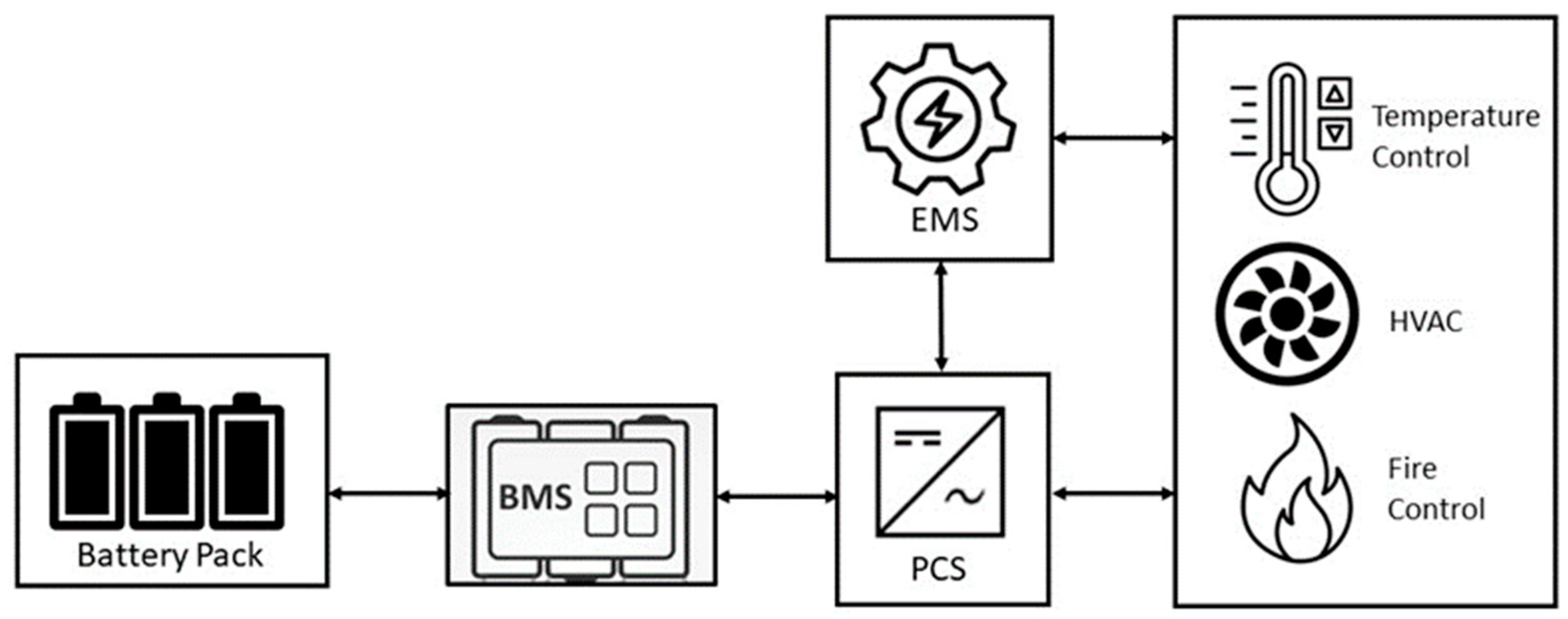
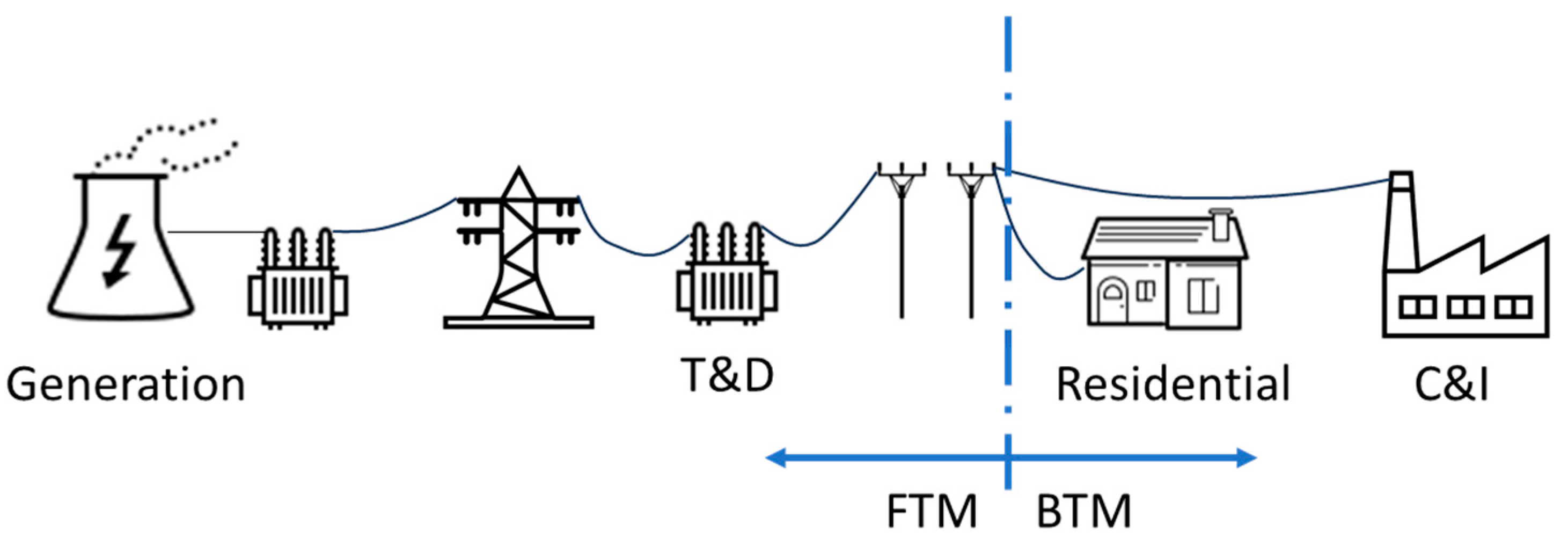
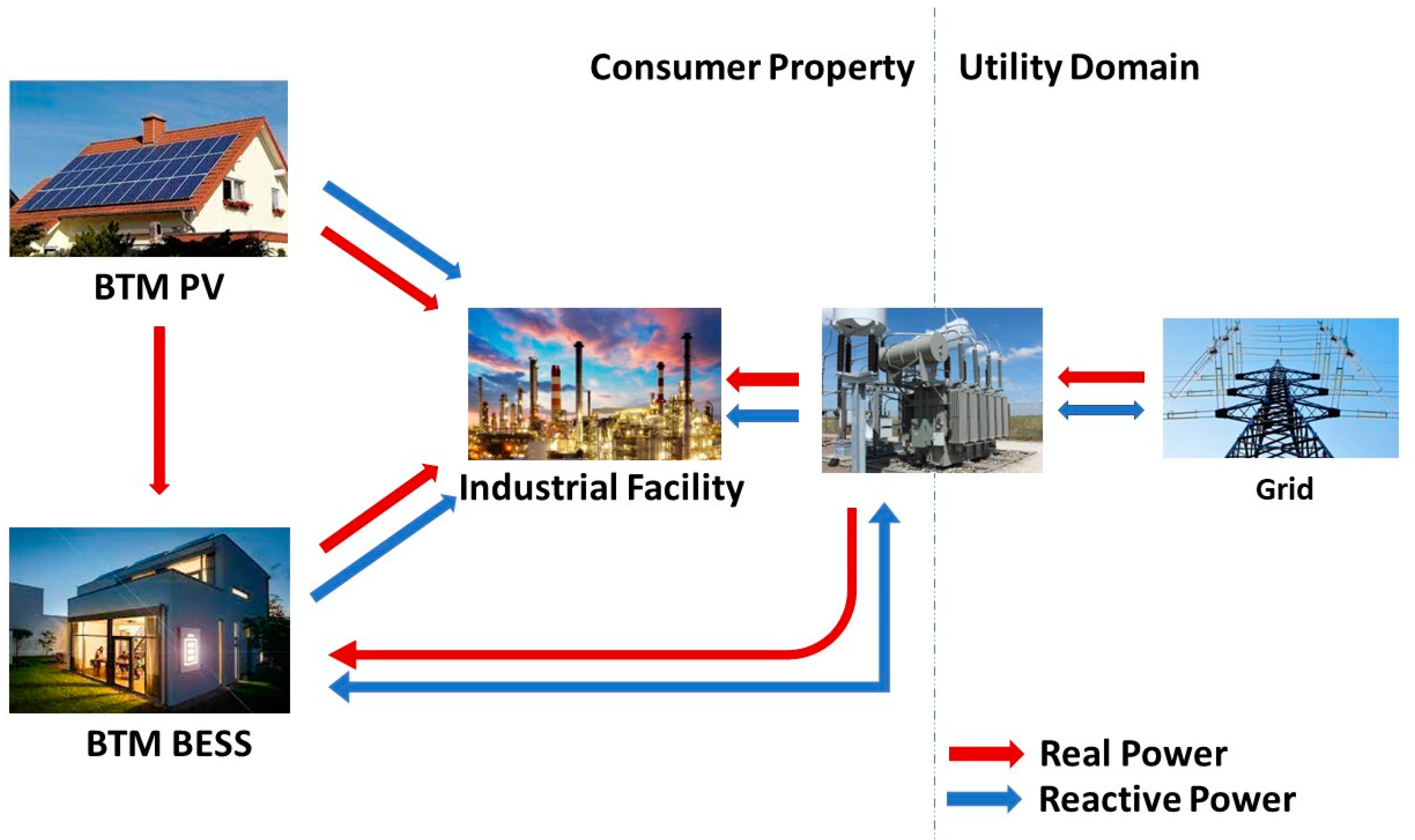
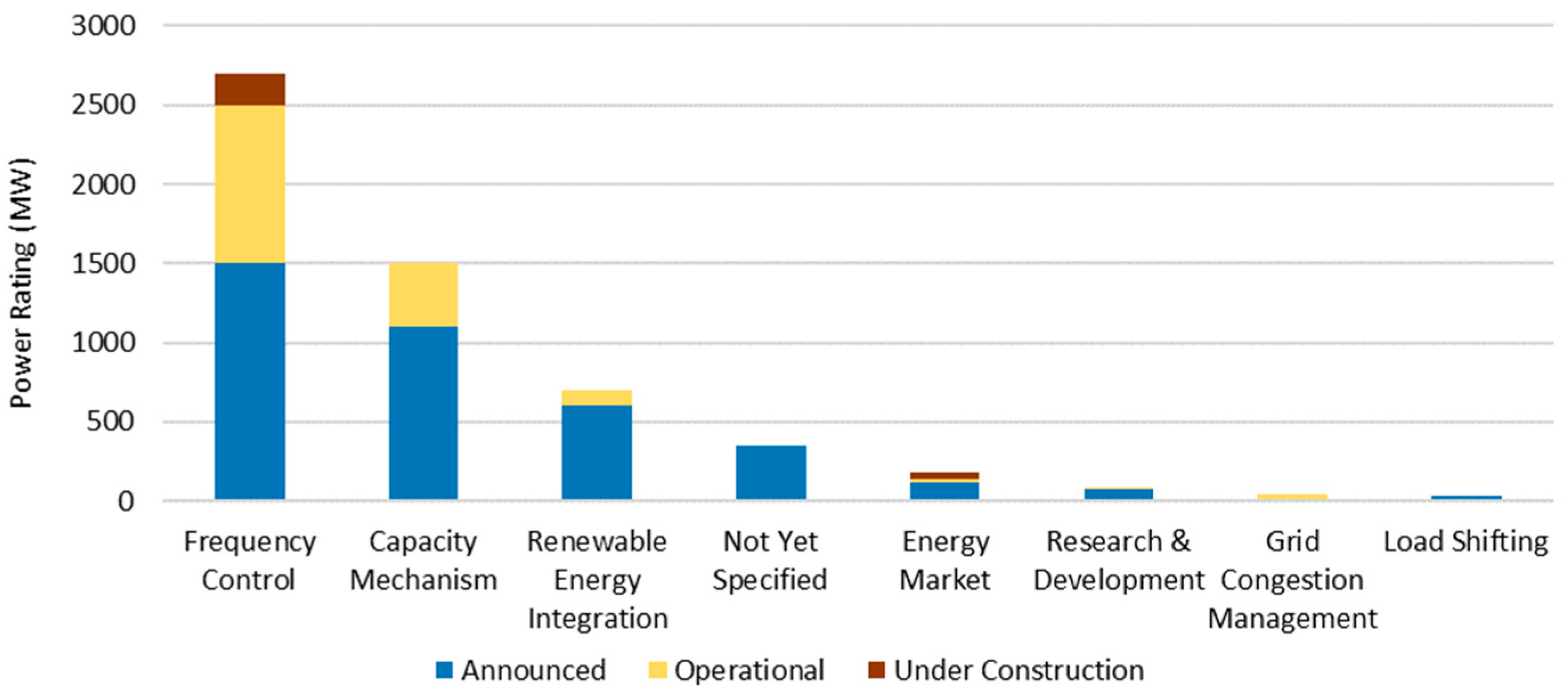
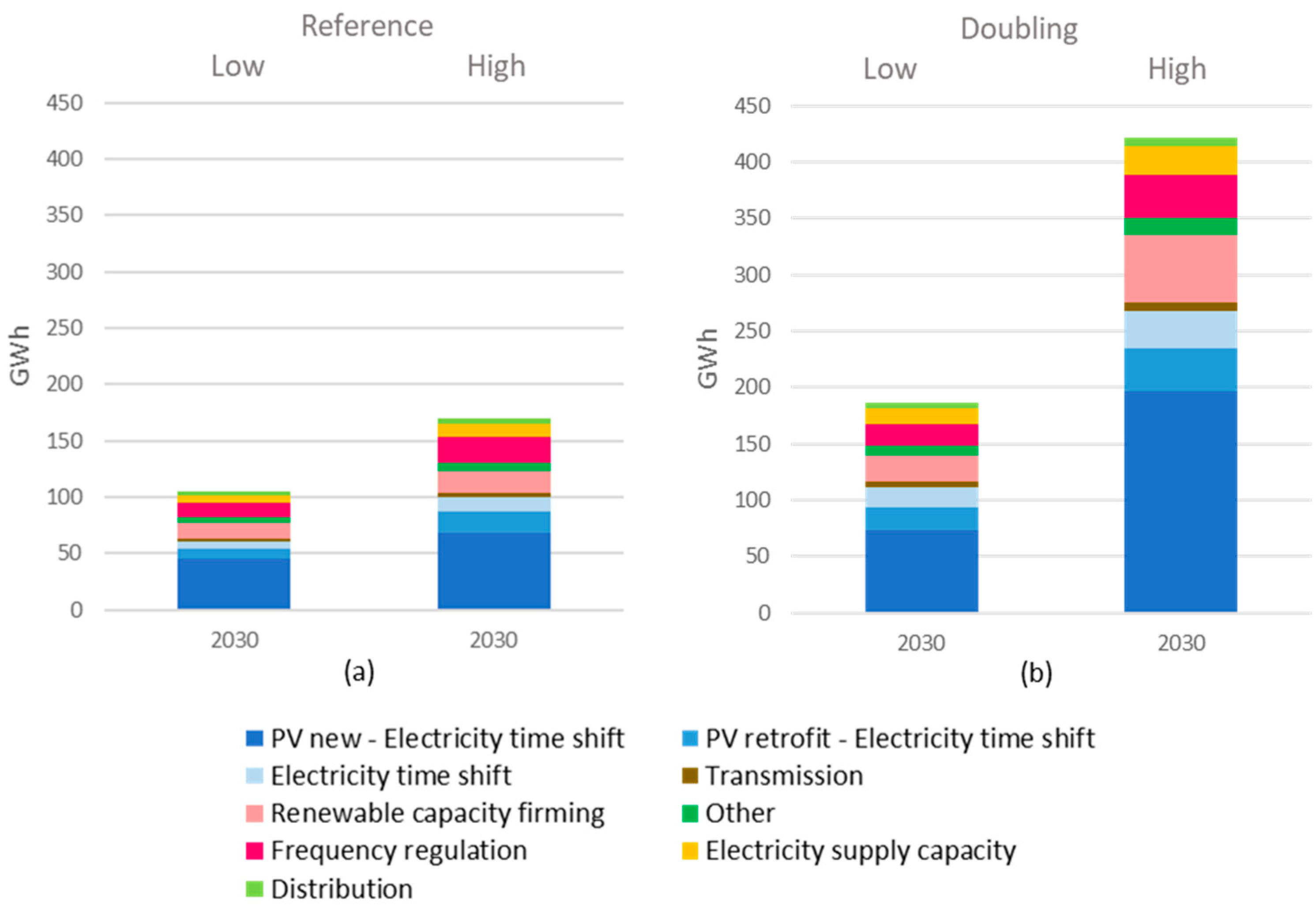
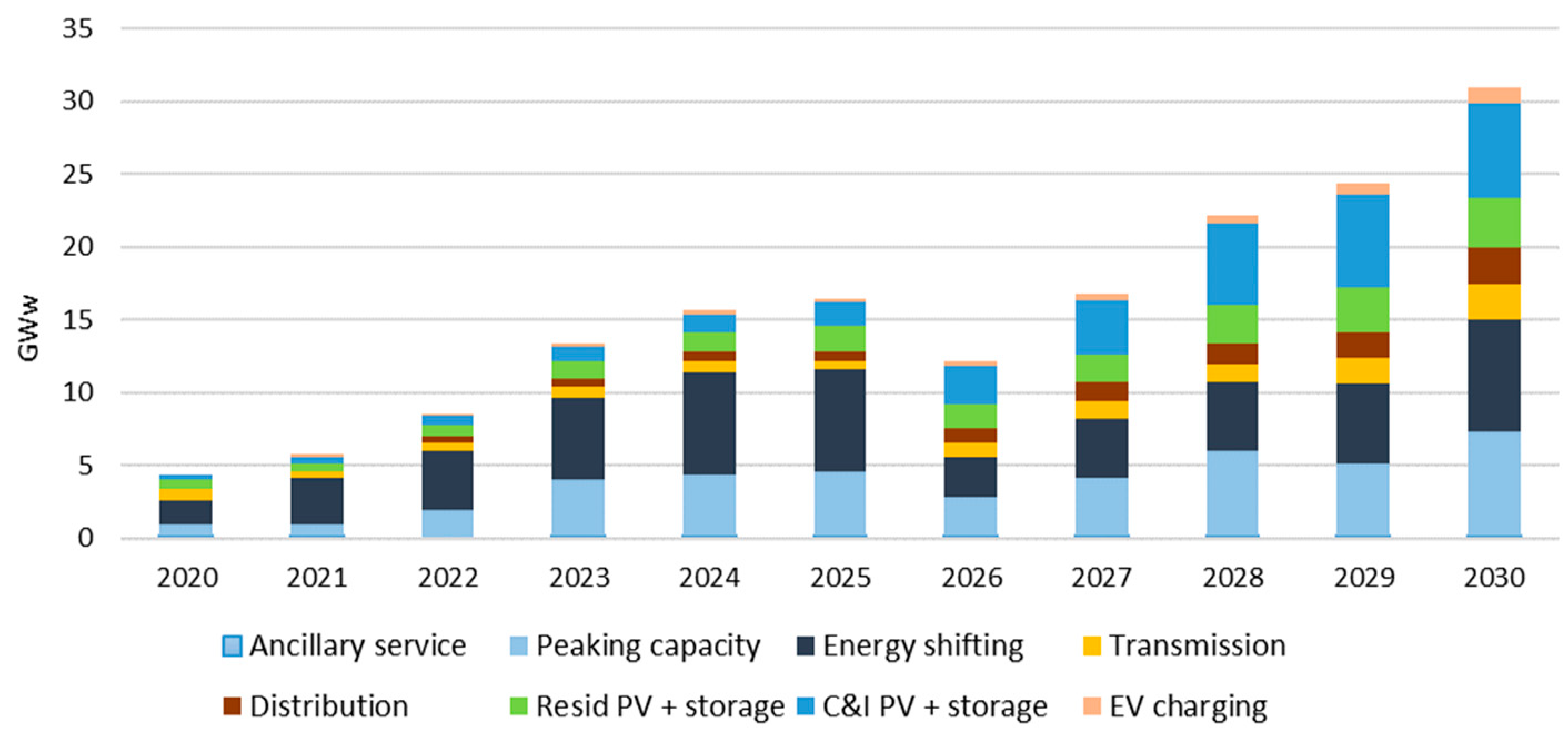

| Topic | Title | Year | Reference |
|---|---|---|---|
| BMS | Battery Energy Storage System (BESS) and Battery Management System (BMS) for Grid-Scale Applications. | 2014 | [16] |
| Energy Management and Optimization Methods for Grid Energy Storage Systems. | 2018 | [18] | |
| Active Battery Management System for Home Battery Energy Storage. | 2020 | [17] | |
| Lithium ion chemistry | Comparison of lead-acid and lithium-ion batteries for stationary storage in off-grid energy systems. | 2016 | [19] |
| Analysis of Advanced Lithium-Ion Batteries for Battery Energy Storage Systems. | 2018 | [21] | |
| Cloud Energy Storage Based Embedded Battery Technology Architecture for Residential Users Cost Minimization. | 2022 | [20] | |
| Services | EV charging station integrating renewable energy and second-life battery. | 2013 | [24] |
| Optimal distributed generation planning in active distribution networks considering integration of energy storage. | 2018 | [25] | |
| Analysis of Energy Storage Systems Application in the Russian and World Electric Power Industry. | 2020 | [27] | |
| A Comprehensive Review of the Integration of Battery Energy Storage Systems into Distribution Networks. | 2020 | [28] | |
| Networked microgrids with roof-top solar PV and battery energy storage to improve distribution grids resilience to natural disasters. | 2020 | [22] | |
| Charging Management of Chemical Lithium Nickel Cobalt Aluminum Oxide (LiNiCoAlO2) Batteries, Considering Battery Degradation Effects under Uncertain Operation in Multi-energy Systems. | 2020 | [23] | |
| A novel hybrid optimization framework for sizing renewable energy systems integrated with energy storage systems with solar photovoltaics, wind, battery and electrolyzer-fuel cell. | 2023 | [26] | |
| Market Trends | Stationary battery systems in the main world markets: Part 1: Overview of the state-of-the-art. | 2017 | [31] |
| Participation of Battery Energy Storage Systems in the Italian Balancing Market: Management Strategies and Economic Results. | 2018 | [29] | |
| The development of stationary battery storage systems in Germany—A market review. | 2020 | [30] |
| LCO | LMO | NMC | LFP | NCA | LTO | |
|---|---|---|---|---|---|---|
| Specific energy [Wh/kg] | 200 | 150 | 220 | 170 | 250 | 70 |
| Energy density [Wh/l] | 400 | 350 | 500 | 350 | 550 | 177 |
| Cycle life | 500–1000 | 300–700 | 2000 | >4000 | 1000 | 15,000–20,000 |
| Discharge rate | 1C | 1C, 10C | 2C/3C | 1C/3C | 2C/3C | 4C/8C |
| Rated voltage | 3.6 | 3.7 | 3.6 | 3.2 | 3.6 | 2.4 |
| Price [$/kWh] | ~123 [50] | ~95 [51] | ~112 [51] | ~100 [51] | ~120 [51] | ~160 [51] |
| Solid-State | Lithium-Ion | |
|---|---|---|
| Electrolyte | Solid | Liquid/Gel |
| Energy density [Wh/kg] | 500–550 | 260–270 |
| Cost [$/kWh] | 80–90 | 151 |
| Weight (80 kWh) [km] | 158 | 500 |
| Size | Smaller | Larger |
| Safety | Low risk of explosion or fire | Risk of explosion or fire |
| BESSs (Lithium-Ion) | Pumped Hydro Storage | Compressed Air Energy Storage | Flywheel Energy Storage | |
|---|---|---|---|---|
| Cost-Effectiveness | Relatively cost-effective | Cost-effective for large-scale, geography-dependent applications | Can be cost-effective for large-scale applications | Competitive for short-duration applications |
| Scalability | Highly scalable | Limited scalability due to geographic constraints | Moderately scalable; geological requirements may limit deployment | Limited scalability due to energy capacity |
| Environmental Impact | Concerns about resource extraction; improving with sustainable chemistry and recycling | Minimal ongoing | Moderate due to energy-intensive compression and expansion; can be mitigated with RES use | Environmentally friendly; no hazardous materials; long lifespan; highly recyclable |
| Applications | Note |
|---|---|
| Utility-Scale Energy Storage | Large-scale FTM BESSs are integrated into the electrical grid at substations. They provide various grid services, such as frequency regulation, voltage support, and energy arbitrage. |
| Renewable Integration | FTM BESSs are paired with renewable energy. They store excess energy generated during periods of low demand or high renewable output and release it during peak demand or when renewable generation is low, helping to balance the grid. |
| Grid Ancillary Services | FTM BESSs are used to provide grid ancillary services like frequency response, spinning reserves, and black start capabilities. These services help maintain grid stability and can be dispatched quickly to address fluctuations in supply and demand. |
| T&D Upgrade Deferral | FTM BESSs can defer the need for expensive upgrades to T&D infrastructure by providing localized grid support and reducing strain on existing infrastructure. |
| Islanded Microgrids | FTM BESSs can be a part of islanded microgrid systems, where they act as the primary source of power during grid outages or in remote areas were connecting to the main grid is not feasible. |
| Applications | Note |
|---|---|
| Residential Settings | BTM BESSs are commonly installed in residential homes. Homeowners use these systems to store excess electricity, then use it when electricity demand is high or during power outages. This helps reduce electricity bills and provides backup power. |
| Commercial Buildings | Many businesses and commercial properties install BTM BESSs to manage their electricity consumption effectively. These systems help reduce peak demand charges, provide backup power during outages, and enhance overall energy efficiency. |
| Industrial Facilities | Industrial facilities often employ BTM BESSs to smooth out electricity demand and reduce utility costs. These systems can be used for load shifting and power quality improvement in manufacturing processes. |
| Microgrid | Some communities and businesses deploy microgrids with BTM BESSs to enhance energy resilience, especially in remote or isolated areas. These systems can operate independently or in conjunction with the main grid. |
| Segment | Services | Use Case/Application |
|---|---|---|
| Front-of-the-meter (Utility Scale) | Bulk Energy Services | Electric supply capacity Electric energy time shift |
| Ancillary Services | Frequency regulation Voltage support Black start Spinning reserve | |
| Grid Support (T&D) | Transmission services (upgrade deferral and congestion relief) Distribution services (upgrade deferral and voltage support) | |
| Renewable Energy Integration | Renewable capacity firming | |
| Behind-the-meter(End-user Scale) | Customer Energy Management Services | Peak shaving Power upgrade deferral Time-of-use energy cost management Maximizing/optimizing self-production Renewable integration Back-up power Power Quality Compensation of the reactive power Energy independence EV fast charging |
| Parameter | Value (a) | Value (b) | Note |
|---|---|---|---|
| Power range [MW]: | 1–500 | 1–500 | Electric supply system |
| Energy range [MWh]: | 1–1000 | 1–1000 | Greater than 1 h service to the grid |
| C-rate: | 0.1–1 | 0.1–1 | Favourable power–energy ratio |
| Chemistry: | NCM— NCA—LFP | NCM— NCA—LFP | High energy density is required to reduce the occupied space |
| 2nd life: | Yes | Yes | Not required hard performance |
| Parameter | Value (a) | Value (b) | Value (c) | Value (d) |
|---|---|---|---|---|
| Power range [MW]: | 1–40 | 1–40 | 5–50 | 10–100 |
| Energy range [MWh]: | 2.5–40 | 0.1–10 | 1–50 | 2.5–100 |
| C-rate: | 1–4 | 1–5 | 1–4 | 1–4 |
| Chemistry: | NCM—NCA—Solid State | NCM—NCA—Solid State | NCM—NCA —Solid State | NCM—NCA —Solid State |
| 2nd life: | No | No | No | No |
| Parameter | Value (a) | Value (b) | Note |
|---|---|---|---|
| Power range [MW]: | 1–100 | 10–100 | Transmission, distribution grid system |
| Energy range [MWh]: | 1–400 | 20–800 | From 1 h to 8 h |
| C-rate: | 0.25–1 | 0.1–0.5 | Favourable power-energy ratio |
| Chemistry: | LFP– Solid State | LFP– Solid State | Suitable for applications requiring high power density |
| 2nd life: | Yes | Yes | Not required hard performance |
| Parameter | Value | Note |
|---|---|---|
| Power range [MW]: | 1–500 | Utility-scale PV, on-shore or off-shore wind farms |
| Energy range [MWh]: | 1–1000 | 2–4 h service to the grid |
| C-rate: | 0.1–1 | Favourable power–energy ratio |
| Chemistry: | NCM—NCA | High energy density is required to reduce the occupied space |
| 2nd life: | Yes | Not required hard performance |
| Power Range [kW] | Energy Range [kWh] | C-Rate | Chemistry | Second Life | |
|---|---|---|---|---|---|
| (a) | 10–1000 | 10–6000 | 0.1–1 | LFP—NMC | Yes |
| (b) | 10–2000 | 10–4000 | 0.5–1 | LFP—NMC | Yes |
| (c) | 10–1000 | 10–4000 | 0.25–1 | LFP—NMC | Yes |
| (d) | 50–250 | 25–500 | 0.1–2 | NMC | Yes |
| (e) | 10–1000 | 10–4000 | 0.25–4 | LFP—NMC | Yes |
| (f) | 10–500 | 10–1000 | 0.5–1 | LFP—NMC | No |
| (g) | 10–1000 | 10–350 | 1–3 | NCM—NCA | No |
| (h) | 50–500 | 50–150 | 1–3 | NCM—NCA | No |
| (i) | 0.1–10 | 0.2–20 | 0.1–1 | LFP—NCA—NMC | Yes |
| (j) | 100–300 | 20–300 | 1–5 | NCM—NCA | Yes |
Disclaimer/Publisher’s Note: The statements, opinions and data contained in all publications are solely those of the individual author(s) and contributor(s) and not of MDPI and/or the editor(s). MDPI and/or the editor(s) disclaim responsibility for any injury to people or property resulting from any ideas, methods, instructions or products referred to in the content. |
© 2023 by the authors. Licensee MDPI, Basel, Switzerland. This article is an open access article distributed under the terms and conditions of the Creative Commons Attribution (CC BY) license (https://creativecommons.org/licenses/by/4.0/).
Share and Cite
Saldarini, A.; Longo, M.; Brenna, M.; Zaninelli, D. Battery Electric Storage Systems: Advances, Challenges, and Market Trends. Energies 2023, 16, 7566. https://doi.org/10.3390/en16227566
Saldarini A, Longo M, Brenna M, Zaninelli D. Battery Electric Storage Systems: Advances, Challenges, and Market Trends. Energies. 2023; 16(22):7566. https://doi.org/10.3390/en16227566
Chicago/Turabian StyleSaldarini, Alessandro, Michela Longo, Morris Brenna, and Dario Zaninelli. 2023. "Battery Electric Storage Systems: Advances, Challenges, and Market Trends" Energies 16, no. 22: 7566. https://doi.org/10.3390/en16227566
APA StyleSaldarini, A., Longo, M., Brenna, M., & Zaninelli, D. (2023). Battery Electric Storage Systems: Advances, Challenges, and Market Trends. Energies, 16(22), 7566. https://doi.org/10.3390/en16227566






